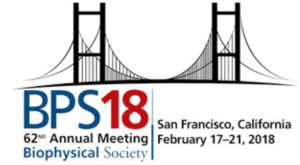conference
Educational webinar on the use of ssNMR to measure dihedral angles.
Recently, Patrick gave an online lecture in the online webinar tutorial series of the Global NMR Discussion Meetings series (episode 70!). In this online lecture he introduced and discussed approaches to measure torsion angles (or dihedral angles) using advanced solid-state NMR spectroscopy. He discussed the basic idea of how these are implemented in ssNMR, but also how such structural data can be a useful complement to more traditional inter-atomic distance information obtained by ssNMR. You can now watch the recording of this lecture on Youtube, via this link.
Want to learn even more?
This lecture is connected to our recent review article on the same topic, which can be found online at: Frontiers | Dihedral Angle Measurements for Structure Determination by Biomolecular Solid-State NMR Spectroscopy (frontiersin.org)
Upcoming event: BPS networking event on polyQ biophysics
Hereby an early announcement of an upcoming online event hosted by our group and the group of Markus Miettinen: “Biophysics of polyglutamine aggregation: how does it start and how does it end?“
This is an online event is organized in context of the networking event series sponsored and organized by the Biophysical Society (BPS). Our event aims to bring together international scientists working on the biophysics of polyglutamine (polyQ) protein aggregation. The event will take place on July 6th 2022, from 15:00-18:00 CET.
More information can be found at the page from the BPS or our own institute. An online registration page is planned to online at the BPS, see below. If you want more information in the mean time, please contact us by email.
Update May 2022: the registration page is now active at the BPS. The link is here. Note that this does require a free BPS account to work. Let us know if you have any issues or questions.
Webinar: Huntington’s disease mechanisms.
On Sept 28 2021, Patrick gave a public webinar on the topic of protein Misfolding and aggregation in Huntington’s disease (and related polyglutamine disorders). This was part of the international webinar series on Cellular and Protein Homeostasis. This webinar is now available for streaming online at the following URL. The webinar discusses some of the lessons we learned from our ongoing studies of what happens to mutated proteins in Huntington’s disease. In particular: what is the role of the mutated polyglutamine domain? How does it change its conformation as it transitions from its normal fold to a disease-causing “misfolded” state?
Title: On the role of beta-hairpins in the nucleation and propagation of polyglutamine protein aggregation.
For more information see also our recent papers in JMB (2020) and EBM (2019).
Webinar: Structural biology of Huntington’s disease.
On May 15th 2021, Patrick gave an invited lecture in the online webinar series on the Molecular Bases of Proteinopathies hosted by the Ramamoorthy lab at the University of Michigan. Patrick talked about our research on polyglutamine protein aggregation and the structural biology of Huntington’s disease.The seminar title was “The Structural Biology of Protein Misfolding in Huntington’s disease”. If you are interested, the seminar has been posted to YouTube, where it can be viewed here.
Webinar: Talk on dynamics ssNMR studies in the Emerging Topics in Biomolecular Magnetic Resonance series
On Thu Feb 18th, Patrick was invited to give a talk in the online Emerging Topics in Biomolecular Magnetic Resonance webinar series. This is a global online seminar series featuring the frontier of research using magnetic resonance spectroscopy (mostly NMR) in biological systems. The webinars are also posted (most of them at least) to the dedicated YouTube channel. Lots of great cutting edge research there!
Patrick presented a combination of published an unpublished research that focused on the studies of how lipid (per)oxidation is catalysed in mitochondria, as part of the mitochondrial apoptotic process. Whilst oxidation of biomolecules (lipids, DNA, proteins) is commonly seen as simply an undesirable negative site effect, recent studies show that in apoptotic mitochondria the process of lipid oxidation is actually being catalysed (and directed!) by a protein-driven enzymatic reaction. We have been studying the underlying molecular events for some years now, resulting in a number of related papers [1-4]. In these papers we initially emphasised how the protein involved (cytochrome c) is surprisingly similar in structure to its native state [1]. In more recent work we are figuring out how this native state is variably “mobilised” in its peroxidase active state, and how this is regulated by the substrate of the peroxidation reaction [3]. This latter story is the focus of the online talk.
The idea of the lipids acting as both substrate and dynamic activator, was introduced in our recent paper in Structure [3]. A paper is forthcoming that will look at this in more detail, with some data shown and discussed in the talk. The talk is now also available on the YouTube channel of the webinar series. (If you go there, hang around for many more interesting talks, including the talk by Roland Riek on automating NMR assignments with new computational approaches, in the same video.)
This research has been supported by funds from the NIH to my group and the group of collaborator Valerian Kagan. The papers below should be available (mostly) as open access, but please requests reprints from us if needed.
Some related papers from the lab:
- Mandal, A.; Hoop, C. L.; DeLucia, M.; Kodali, R.; Kagan, V. E.; Ahn, J.; van der Wel, P. C. A. Structural Changes and Proapoptotic Peroxidase Activity of Cardiolipin-Bound Mitochondrial Cytochrome c. Biophys. J.2015, 109(9), 1873–1884. https://doi.org/10.1016/j.bpj.2015.09.016.
- Our first studies of the CytC-CL complex by ssNMR.
- Mandal, A.; Van der Wel, P. C. A. MAS (1)H NMR Probes Freezing Point Depression of Water and Liquid-Gel Phase Transitions in Liposomes. Biophys. J.2016, 111 (9), 1965–1973. https://doi.org/10.1016/j.bpj.2016.09.027.
- A question was asked about phase transitions. We look at this by ssNMR in this paper. Also earlier work on VDAC may be relevant.
- Li, M.; Mandal, A.; Tyurin, V. A.; DeLucia, M.; Ahn, J.; Kagan, V. E.; van der Wel, P. C. A. Surface-Binding to Cardiolipin Nanodomains Triggers Cytochrome c Pro-Apoptotic Peroxidase Activity via Localized Dynamics. Structure2019, 27 (5), 806-815.e4. https://doi.org/10.1016/j.str.2019.02.007.
- Kagan, V. E.; Tyurina, Y. Y.; Sun, W. Y.; Vlasova, L. L.; Dar, H.; Tyurin, V. A.; Amoscato, A. A.; Mallampalli, R.; van der Wel, P. C. A.; He, R. R.; Shvedova, A. A.; Gabrilovich, D.; Bayir, H. Redox Phospholipidomics of Enzymatically Generated Oxygenated Phospholipids as Specific Signals of Programmed Cell Death. Free Radic Biol Med2020, 147, 231–241. https://doi.org/10.1016/j.freeradbiomed.2019.12.028.
- Talks about the role of purposely catalysed enzymatic lipid peroxidation as a signal in biology.
Online presentation: our work featured in the Polymer Physics & Polymer Spectroscopy (P3S) webinar series
Patrick was invited to present some of our work in the P3S webinar series organised by three research groups from Europe, China and the US. This recurring series has included many interesting talks on studies of polymers and hydrogels by various spectroscopic techniques, with a recurring role for (solid-state) NMR spectroscopy. Patrick spoke about our published work on studying the repeating polymer structures of polyglutamine proteins [1] and (briefly) our newer investigations of polysaccharide hydrogels [2] . In the former topic, the talk discussed the use and benefits of torsion angle measurements by solid-state NMR, as demonstrated in our prior work on various different samples [1,3-4].
The talk was recorded and can be found in the P3S online archive, with the specific talk linked here.
- Hoop, C. L.; Lin, H.-K.; Kar, K.; Magyarfalvi, G.; Lamley, J. M.; Boatz, J. C.; Mandal, A.; Lewandowski, J. R.; Wetzel, R.; van der Wel, P. C. A. Huntingtin Exon 1 Fibrils Feature an Interdigitated β-Hairpin-Based Polyglutamine Core. Proc. Natl. Acad. Sci. USA 2016, 113 (6), 1546–1551. https://doi.org/10.1073/pnas.1521933113.
- El Hariri El Nokab, M.; van der Wel, P. C. A. Use of Solid-State NMR Spectroscopy for Investigating Polysaccharide-Based Hydrogels: A Review. Carbohydrate Polymers 2020, 116276. https://doi.org/10.1016/j.carbpol.2020.116276.
- Bajaj, V. S.; van der Wel, P. C. A.; Griffin, R. G. Observation of a Low-Temperature, Dynamically Driven Structural Transition in a Polypeptide by Solid-State NMR Spectroscopy. J Am Chem Soc 2009, 131 (1), 118–128. https://doi.org/10.1021/ja8045926.
- Van der Wel, P. C. A.; Lewandowski, J. R.; Griffin, R. G. Structural Characterization of GNNQQNY Amyloid Fibrils by Magic Angle Spinning NMR. Biochemistry 2010, 49 (44), 9457–9469. https://doi.org/10.1021/bi100077x.
Webinars of interest (during COVID)
During the COVID19 pandemic many conferences were cancelled, but also various interesting new online alternatives came into being. Below are a few relevant seminar series with relevance to our past and current research.
- Protein aggregation & chaperones
- NMR related
- Emerging Topics in Biomolecular Magnetic Resonance (YouTube)
- Global NMR Discussion meetings (YouTube)
- MIT SSNMR/DNP zoom seminars
- P3S seminars MLU Halle
- ICMRBS Early Careers Seminars
- Intercontinental NMR Seminar Series (ICONS2020)
- Membranes and lipids
- Biophysics
Van der Wel lab at the Biophysical Society Meeting in San Francisco!
This coming week the Van der Wel lab will be represented at the annual meeting of the Biophysical Society, taking place in San Francisco. As summarized below, a recurring theme in the presented work will be the impact of oxidative damage in health and disease.

Dr. Mingyue Li will present her studies of mitochondrial protein-lipid interactions during her platform session talk on Monday Feb. 19 (1130AM; 999-PLAT). She will talk about the structure and dynamics of the cardiolipin-cytochrome c complex that is implicated in the early stages of mitochondrial apoptosis. This protein/lipid complex features a peripherally bound protein that facilitates the oxidation of poly-unsaturated cardiolipin lipids.
Jennifer Boatz will present a poster on Feb 21st (2815-Pos; B23) on her use of magic-angle-spinning NMR and electron microscopy to probe the aggregated state of apolipoprotein A1, in presence and absence of methionine oxidation. Aggregated ApoA1 is a prominent component of deposits formed during atherosclerosis. For more information see Jennifer’s poster and our in-press collaborative publication in the FASEB Journal.
ENC NMR conference coming to Pittsburgh
This coming spring the Experimental NMR Conference (ENC) is returning to Pittsburgh. The ENC poster, including a list of invited speakers, is available here. To submit your abstract, go to this page by Jan 8th 2016 (which is the abstract deadline). The registration deadline is March 18th 2016.
Dates: April 10-15, 2016
Location: Wyndham Grand Pittsburgh Downtown
Program: ENC website
Biophysical Society meeting news!
Congratulations to Jennifer and Abhishek, for being selected for a talk and awarded travel grants for the coming Biophysical Society Meeting in San Diego! We look forward to seeing you there, and tell you more about our studies of protein deposition diseases and protein-lipid interactions.
Update: see also the press release by the Biophysical Society.
